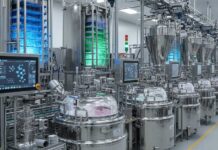Researchers have developed a method to predict the cell activity in tissues over time. The method involves new software that combines genomics technologies with computational modeling. This software predicts cell changes in behavior, such as communication between cells that could cause cancer cells to flourish.
Researchers at the University of Maryland School of Medicine’s (UMSOM) Institute for Genome Sciences (IGS) co-led the study, which was published online on July 25 in the journal Cell. It is the product of a multi-year, multi-lab project at the interface of software development with significant collaboration between bench and clinical team science researchers. This study involving software to predict cell activity ultimately could result in computer programs that would be able to assist in identifying optimal treatment for cancer patients by basically generating a “digital twin” of the patient.
“Although standard biomedical research has made immeasurable strides in characterizing cellular ecosystems with genomics technologies, the result is still a single snapshot in time-rather than showing how diseases, like cancer, can arise from communication between the cells. Cancer is controlled or enabled by the immune system, which is highly individualized; this complexity makes it difficult to make predictions from human cancer data to a specific patient.”, said Jeanette Johnson, PhD, a Postdoc Fellow at the Institute for Genome Sciences (IGS) at UMSOM and co-first author of the study
This study that involves software to predict cell activity stands out as it uses simple language “hypothesis grammar” that uses common language as a bridge between biological systems and computational models and simulates how cells act in tissue.
Paul Macklin, PhD, Professor of Intelligence Systems Engineering at Indiana University led a team of researchers who developed the grammar to describe cell behavior. The grammar enables scientists to construct digital models of multicellular biological systems using simple sentences in English language and facilitated the creation of computational models for diseases as complicated as cancer.
“As much as this new ‘grammar’ enables communication between biology and code, it also enables communication between scientists from different disciplines to leverage this modeling paradigm in their research,” said Daniel Bergman, PhD, a scientist at IGS and Assistant Professor of Pharmacology and Physiology at UMSOM and co-leading author with Dr. Johnson.
Dr. Bergman and his colleagues at IGS then subsequently paired this grammar with genomic information from actual patient samples to investigate breast and pancreatic cancer, using technologies like spatial transcriptomics.
In breast cancer, the IGS team modeled an effect in which the immune system is unable to restrain growth of tumor cells and facilitates invasion and cancer dissemination. They extended this computational modeling framework to model a real-world immunotherapy clinical trial of pancreatic cancer.
Using genomics data from untreated tissue samples of pancreatic cancer, the model was able to predict that every virtual “patient” responded differently to the immunotherapy treatment-highlighting the significance of cellular ecosystems to precision oncology. For instance, pancreatic cancer is a challenging cancer to cure, partly because it is usually encased by a dense fibroblast structure of non-cancer cells. The researchers employed novel spatial genomics technology to further illustrate how fibroblasts interact with tumor cells. The program enabled the researchers to observe the development and progression of pancreatic tumors to invasion from real patient tissue.
“What makes these models so exciting to me as someone who studies immunology is that they can be informed, initialized, and built upon using both laboratory and human genomics data,” said Dr. Johnson. “Immune cells are amazing and follow rules of behavior that can be programmed into one of these models. So, for instance, we can take data and treat it as a snapshot of what the human immune system is doing, and this framework gives us a sandbox to freely investigate our hypotheses of what’s happening there over time without extra costs or risk to patients.”
“Ever since my transitioning from my training in weather prediction at the University of Maryland, College Park into computation, I have believed that we could apply the same principles to work across biological systems to make predictive models in cancer. I am struck by how many rules of biology we don’t yet know,” said Elana J. Fertig, PhD, Director of IGS, Associate Director of Quantitative Sciences for the Greenebaum Comprehensive Center, and Professor of Medicine and Epidemiology at UMSOM and a lead author on the study. “Adapting this approach to genomics technologies gives us a virtual cell laboratory in which we can conduct experiments to test the implications of cellular rules entirely in silico.”
Dr. Fertig calls the research “a tapestry of team science” with additional validation of the computational models coming from clinical collaborators at Johns Hopkins University and Oregon Health Sciences University. The National Foundation for Cancer Research funded the project.
The new grammar is open source so that all scientists can benefit from it. “By making this tool accessible to the scientific community, we are providing a path forward to standardize such models and make them generally accepted,” said Dr. Bergman. To demonstrate this generalizability, Genevieve Stein-O’Brien, PhD, the Terkowitz Family Rising Professor of Neuroscience and Neurology at Johns Hopkins School of Medicine (JHSOM) led researchers in using this approach in a neuroscience example in which the program simulated the creation of layers as the brain develops.
“With this work from IGS, we have a new framework for biological research since researchers can now create computerized simulations of their bench experiments and clinical trials and even start predicting the effects of therapies on patients,” said Mark T. Gladwin, MD, Vice President for Medical Affairs at the University of Maryland, Baltimore, and the John Z. and Akiko K. Bowers Distinguished Professor and UMSOM Dean. “This has important applications to enable digital twins and virtual clinical trials in cancer and beyond. We look forward to future work extending this computational modeling of cancer to the clinic.”



























